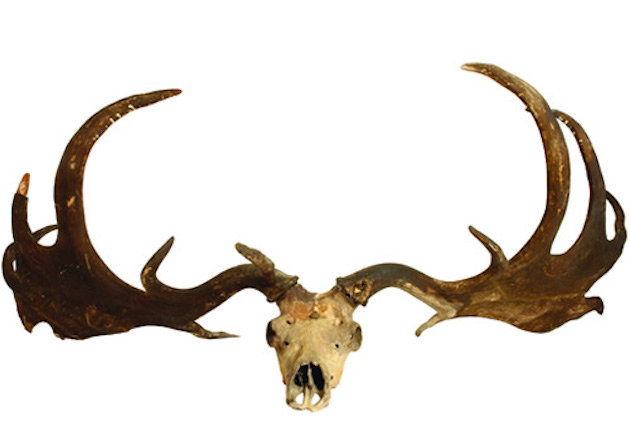A fossilized elk rack spanning ten and a half feet wide recently sold at auction for $28,000. The rare antlers and skull of an extinct Irish elk (Megaloceros giganteus) sparked a bidding war November 8, with the winner carrying away a pricey piece of history.
The antlers were sold at auction in Auckland, New Zealand, by Cordy’s Auction House. Sold as Lot Number 093, the set of antlers was appraised for $8,000-$15,000 because of damage to the antlers and/or skull. Restoration work had previously been attempted, with pin fittings present in the skull as a result.
That didn’t deter four phone bidders. The idea of an ancient, 10½-foot rack was too much of a temptation, with the four eventually raising the bid to $28,000.
No word on who won the bidding or where the antlers will relocate to, but this originally Irish elk has been in New Zealand since the early 20th century. It was first discovered, like so many others of its kind, in an Irish bog, later becoming the property of Major Robert Adams Wilson, a World War I veteran turned dairy/sheep farmer on the North Island.
Wilson hung the antlers in the master bedroom of his private hunting lodge until his death in 1964, at which point he bequeathed them to his son. Two years ago the son ceded them to a family friend, Michael McIntosh, who simply didn’t have the room to properly and safely display them. He contacted Cordy’s and put the auction in motion.
While $28,000 is nothing to sneeze at, it’s a downright steal compared to other Irish elk racks that have been auctioned off in the past. The New Zealand Herald reports that one rack sold in London in 2003 for $83,000; another in Ireland in 2001 for $131,000. Perhaps the highest-grossing rack so far is one sold in 2003 for $143,000.
As big as this latest rack is in size, it’s average at best for an Irish elk. The American Museum of Natural History says some Irish elk antlers reached 13 feet in width, with the animals themselves weighing 1,500 pounds or so. Known as the Irish elk because it was first discovered in that country, these massive deer also called the European mainland home, as well as parts of North Africa and Asia. Scientists believe they went extinct some 10,000 years ago at the end of the last ice age.

